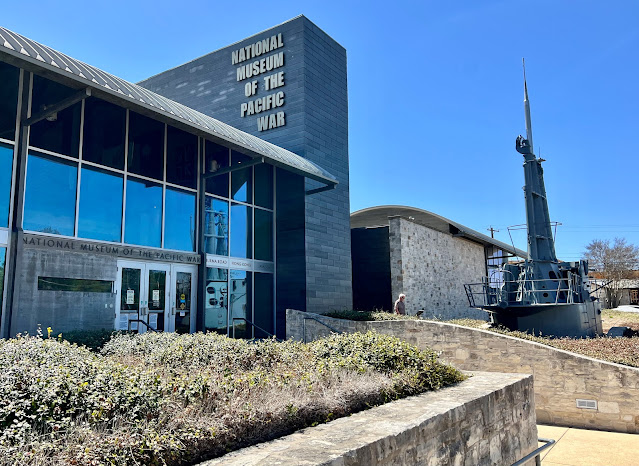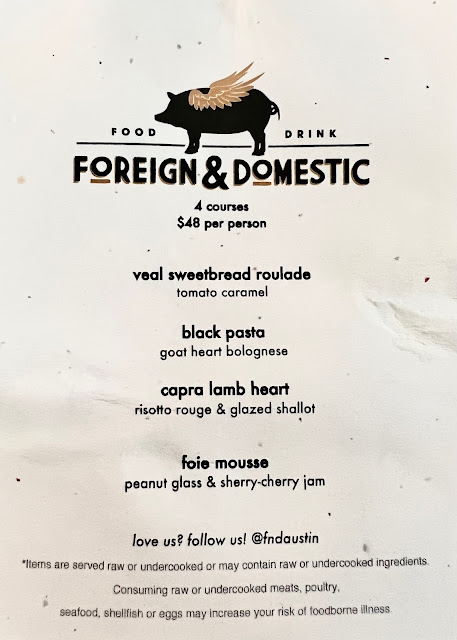The final days of our second week on the road were defined by museums., two of which we had planned to see earlier, only to be foiled by their odd hours.
The Panhandle - Plains Historical Museum is located on the campus of Texas A&M's West Texas branch in Canyon, Texas. Established in 1932, it has an appropriately institutional facade.
It opened at 9 am Tuesday morning, and we were waiting eagerly for the doors to open. After all, we had many hours of driving and two more museums to visit.
We had come mainly to see the exhibit on Native American life on the plains. We were surprised that there really wasn't much Native Americana, and also at how well the exhibits they did have were done.
The paleontological section featured a beautifully preserved skull of one of O's ancestors.
The slingshot deer is a close relation.
When a goat has serious horn envy.
Most of the museum is dedicated to the life of nineteenth-century Americans of the European persuasion, including a recreation of a small town with homes, hotel, livery stable, church, land office, and general store.
There was also, of course, a big section dedicated to the evolution of the petroleum industry.
I loved this 1910 automobile.
And this 1928 Cadillac V-16. It is gorgeous, but at 8 miles per gallon, we're glad to be driving our hybrid on this trip.
Apparently, even the buffalo here are into Jesus.
Next stop was the Bob Will Museum in Turkey, Texas, an hour and a half away on dusty backroads.
Turkey is a typical small Texas panhandle town. The Bob Wills Museum is its only attraction. Now, Bob Wills wasn't born here, but he did live for a while as a child.
Whatever. Turkey has embraced his legacy. Every year in April, they celebrate Bob Wills Day. We just missed it by two weeks.
One of Bob's touring buses.
Everything revolves around Bob because there isn't much else going on here.
The main street is mostly boarded-up.
Hotel Turkey has seen better days.
In spite of the ubiquity of Bobmania, the museum was hard to find. We had spent a bit more time in the Panhandle-Plains Museum the we'd planned, and we were disappointed to see that the museum was closed from 11:30 to 1:00. We were due to arrive at 11:20 and really didn't want to cool our heels for an hour and a half. We had miles to go, and wanted to get on with it.
Finally, we stopped at a small brick building with a poster of Bob outside. I went in to ask directions. It turned out to be City Hall. There was one woman working in the otherwise empty building.
The Bob Wills Museum. Oh, it's just down the hall.
It was. And it was closed. Oh, don't worry, just go on in, she said.
And so we did.
It was a small place, two rooms with a timeline of Bob's career.
Some cool posters. I would have loved to see this concert.
I knew that the most successful part of Bob's career had been spent not in Texas, but in California. But I had no idea that he and the Playboys appeared in several popular movies.
We stopped for lunch at the Bison Cafe in Quitaque. It took over an hour for our food to come (they said it was slow food). It was quite tasty, but we lost as much time as we would have if we'd waited for the museum to open at 1:00.
As we rolled through another maze of backroads toward Lubbock and the Buddy Holly Center, Siri serenaded us with the hot swing of the Texas Playboys, recorded live in Santa Monica at the height of their popularity.
The Buddy Holly Center was as professionally put together as the Bob Wills Museum was not. Buddy's 18-month career was well documented with photos, film, and memorabilia. It's remarkable what an impact he made in such a short time. And sad to think what might have been.
The Center doesn't allow photos, so I have none to share. You'll just have to go there on your own.
After leaving Lubbock, we drove southeast through high winds a blowing dust to San Angelo.
The next morning, the winds were still high, but the dust abated as we left the flat expanse of the panhandle behind us and climbed into the Texas hill country.
Well, they call it hill country. To those of us from the mountainous west it's more like a few minor corrugations on the vast flat plains of Texas. But unlike unbroken sameness of the panhandle, there were at least trees.
Our first destination was the small town of Fredricksburg. It is a charming tourist town, reminiscent of the Gold Rush towns in the Sierras foothills of California.
The area was settled by German immigrants starting in the early 1800s, and much of the town's identity still revolves around that heritage. So we figured we could get some good German food, a cuisine I crave maybe once a year.
But for some inscrutable Teutonic reason, most of the German restaurants we found on the web were closed on Wednesday.
Finally, we found Der Lindenbaum.





























2 comments:
I love Austin. My sister lives just off South Congress Ave. so I have spent a lot of time walking in her funky neighborhood with its combination of Victorian mansions, post war bungalows, and ultra modern chic homes. I didn't know about the museum in Fredericksburg. The town seemed too aggressively into wine tours, but the hill country is where my sister owned a winery which she sold a few years ago. I think the hill country is beautiful.
Linda
The buff buffalos for Jesus remind me of The Righteous Gemstones on HBO. Have you watched it? Highly recommend.
Post a Comment